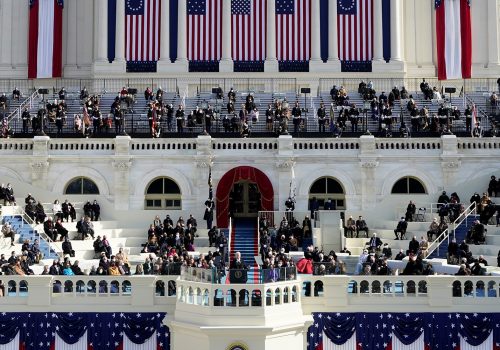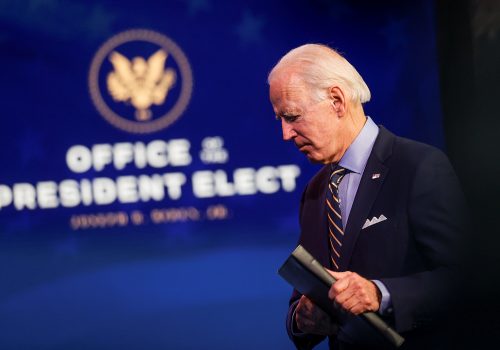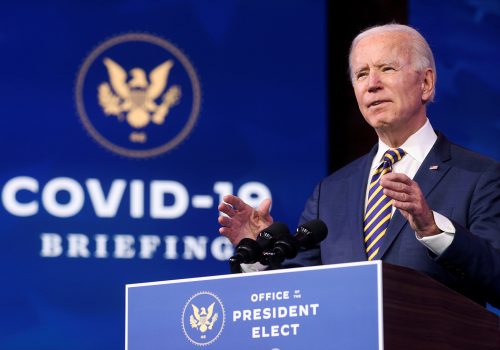Three possible futures for the Biden presidency
While it might seem like an academic exercise, imagining future scenarios is actually crucial to developing strategy. It offers foresight into how one’s plans might succeed or fail. And given the state of the world now arrayed before the new US president, Joe Biden has a whole lot of strategizing to do.
Biden’s successes or failures will be determined by how the paradoxes of his presidency play out. The president is pursuing an extraordinarily ambitious social, economic, and foreign-policy agenda amid an exceptionally dire pandemic and recession—and with a razor-thin congressional majority, no less. He hopes to restore comity and bipartisan compromise to Congress, but his legislative skills will be tested by an obstinate Republican Party and worsening political tribalism.
American presidents have more room for maneuver in international affairs, and many US allies are cheering for a stronger and more engaged United States. But Biden will have to dispel the distrust and perceptions of US unreliability that former President Donald Trump sowed in many foreign capitals—while navigating a more fragmented international system. These challenges will hamper Biden’s efforts to enhance global cooperation on mitigating the pandemic, confronting the ever more dangerous threat of climate change, keeping a fragile, debt-laden global economy from producing another global financial crisis, and managing intensifying strategic competition with China.
Below, we survey this landscape of promise and peril, laying out three potential futures for the new US administration.
Scenario #1: Biden is stifled
Biden’s first one hundred days focus mainly on mass vaccinations, steps to reopen the economy and schools, and wholesale reversal of Trump’s executive orders. With backing from a centrist caucus of more conservative Democrats and anti-Trump Republicans, he passes COVID-19 relief for state and local governments, small businesses, and restaurants. By June, 60 percent of Americans are vaccinated. With phased re-openings, the economy begins to recover.
Yet Biden’s ability to govern is still heavily constrained by partisanship. Trump agitates from outside government against both Biden and any Republican willing to work with him. Congressional Republicans, in turn, fear compromises will alienate them from the Trumpian base, which has largely embraced or at least accepted his manufactured election grievances and extra-constitutional antics. The Biden administration’s climate policies must be scaled back. Tax legislation, foundational to the Biden agenda, becomes problematic. Attempts to add a public option to the Affordable Care Act or pass immigration reforms are hindered by filibuster threats.
Overseas Biden rejoins international institutions and agreements and moves to rejuvenate alliances and multilateral cooperation. But the world, in many cases, has other plans.
The United States seeks ways to re-enter its 2015 nuclear deal with Iran and other world powers. But that pursuit sputters when Tehran calls for major US sanctions relief as a pre-condition of rejuvenating the agreement and initiating new negotiations—while insisting Washington curb its arms sales to Persian Gulf states in exchange for Tehran halting its own missile sales and development. Iran’s demands provoke an outcry in the US Congress and in Israel. Ultra-conservatives win Iran’s election in June.
On the global economic front, COVID-19 travel restrictions linger as the Biden administration worries about new variants of the virus finding their way to the United States. A few Latin American, African, and other developing countries nearly default on their debt, triggering fears of a global financial crisis and an emergency Group of Twenty (G20) meeting to manage debt. There, China refuses to back Washington’s plan for reviving the global economy, dooming the effort.
European allies are eager to renew close ties with the United States, but efforts to build a “tech alliance” run into snags. There is lingering distrust after the European Union (EU) ignores Biden’s warnings about its investment deal with China. The EU Commission goes ahead with its plan to break up big technology companies, prompting members of Congress to threaten sanctions against Brussels.
Congress, where many view authoritarian China as a grave threat, impedes Biden’s efforts to create a stable framework to manage international competition with Beijing. The president’s attempts to build on Trump’s trade deal and start a strategic dialogue with Beijing come under scrutiny. Having reached a common position with the EU, Japan, and Australia, Biden moves to reform the World Trade Organization (WTO) and end loopholes that allowed China to game the system. But a combination of anti-trade progressives and Trumpian Republicans push back against the plan in Congress.
Scenario #2: Biden presides over a US rebirth
Facing possible tax and bank-related fraud charges and struggling to deal with his enormous debts, Trump begins to fade as a political factor. Congressional Republicans feel less beholden to Trump’s base as they jockey for the 2024 presidential nomination.
Meanwhile, Biden’s pandemic plans succeed and 70 percent of Americans are vaccinated by June. As phased re-openings proceed, demand that was pent up during the pandemic drives a surge in economic growth, dubbed the “Biden boom,” beginning in the second quarter of 2021. Biden passes a $1.9 trillion relief-and-recovery act to rejuvenate restaurants, small businesses, and startups while shoring up state and city budgets. He gains support for a bipartisan infrastructure bill that invests in rail and urban transport, diversifies the geography of tech-innovation hubs, boosts renewable energy, and retrofits buildings for net-zero emissions, creating one million jobs by 2023.
With some bipartisan support, Biden renovates and expands AmeriCorps into a national-service program linked to student-debt forgiveness, tuition aid, and job-training credits. The Affordable Care Act is stabilized and health-insurance exchanges are expanded, but no public insurance option is introduced. A new immigration bill based on the 2013 “Gang of 8” proposal fails, but immigration-reform efforts continue as many Republicans seek to expand their appeal to Latinos. With backing from both parties, Biden pursues new workforce-training programs modeled on those in Germany and Singapore along with legislation to bring semiconductor manufacturing to the United States. With no public or congressional support for tax hikes, Biden’s energy and climate agenda is limited. But he is still able to focus the nation’s attention on climate change as extreme weather events occur more frequently. He gradually builds support, including among some free-market Republicans, for a revenue-neutral carbon tax. He also musters backing from Republicans and Democrats for antitrust efforts against Big Tech, forcing some companies to break up.
In the foreign-policy realm, Biden’s efforts to forge a common position with the EU, Japan, and Australia on China’s trade transgressions succeed. This pushes China to open its markets more and reduced state subsidies, which spurs the administration with centrist backing in Congress to call for a restructured WTO with a more narrowly defined dispute-resolution mechanism. (The EU, dependent on China for exports, is nevertheless reluctant to confront Beijing on technology and human-rights issues, frustrating US policymakers.)
Facing the prospect of new trade restrictions by the US, EU, Japan, and Australia, along with the threat of new COVID-19 strains, China agrees to a World Health Organization-led coronavirus truth commission, which includes American scientists, to investigate the origins of the virus. This reduces the febrile tone of US-China relations, and the two countries begin earnest efforts to create a framework to manage strategic competition. China even agrees to a dialogue with the United States to reduce risks associated with their nuclear-weapons arsenals.
The world remains in recession during 2021. The Eurozone struggles to recover. Fears of a new global financial crisis grow, spurred by a wave of debt defaults in Latin America and Africa. This leads to political turmoil and chronic food shortages in parts of both continents. An emergency G20 meeting reaches an accord, with US and Chinese support, on a mix of debt forgiveness to the world’s poorest nations and a new tranche of International Monetary Fund resources to boost their economies. The US Treasury Department and Federal Reserve lead efforts to overcome congressional resistance to the plan.
The Biden administration moves cautiously on Iran policy, holding back-channel talks with Iranian officials. Small, incremental agreements build some trust between the parties. The United States then returns to the nuclear deal based on Iran’s commitment to end uranium enrichment in exchange for the US reducing sanctions. It’s a preliminary step on the way toward Washington lifting its sanctions in return for Iran’s agreeing to extend the fifteen-year time horizons for restrictions on its nuclear program and negotiate limits on its missile program. The Gulf states and Iran, both wary of war, take tentative steps toward regional détente.
Scenario #3: Biden is overwhelmed by events
The Biden administration is inundated by international crises that eclipse its planned agenda at home and abroad, in yet another affirmation of the aphorism famously attributed to former British Prime Minister Harold Macmillan: that the course of governments is often determined by “events, dear boy, events.”
China initially welcomes Biden’s efforts to lower tensions, but his administration is compelled to take a harder line in response to graphic revelations in the media of torture inside Uighur detention camps. Biden tightens rules against Americans and others doing business in the Xinjiang region and imposes new sanctions on Chinese entities with links to Beijing’s repression of its Uighur minority. Biden personally instructs the US ambassador in Beijing to make the treatment of Uighurs the top issue in all meetings with Chinese officials. The Chinese government reacts by refusing to see US embassy officials.
With Sino-American relations at a standstill, talks on lifting US tariffs against Chinese goods and reducing restrictions on China’s high-tech companies are put on hold. Democrats as well as Republicans warn Biden against “going soft” on China.
The retirement of German Chancellor Angela Merkel after general elections in September changes the country’s policy on China. Berlin calls for punitive measures over Beijing’s sluggishness in opening new sectors of its economy to European investors. Brussels suspends the recent EU-Chinese investment treaty until Beijing fulfills its commitments. The Chinese retaliate by slapping quotas on the number of German cars that can be exported to China. Under pressure from human-rights NGOs, the EU begins to levy sanctions on Chinese companies with links to the repression in Xinjiang.
The escalation of tit-for-tat measures by the US, the EU, and China starts to ripple through all three economies. Stock markets dive, amid the onset of a historic decoupling between China and the West. Chinese President Xi Jinping fans anti-Western nationalism and escalates pressure on Taiwan. Beijing ejects the one million Taiwanese living on the mainland and seizes their businesses. It blocks internet connectivity with the island and ends cross-Strait flights.
Meanwhile, in the Middle East, Palestinian demonstrations turn violent following the announcement of more Jewish settlements in East Jerusalem and the West Bank. During the crisis, Israel discovers that Iran has stepped up its delivery of precision rockets and technical advisers to Hezbollah in Lebanon and Hamas in the Gaza Strip. US negotiations with Iran over restoration of the nuclear deal break down, vindicating the view of Iran’s ascendant hard-liners.
Israel decides to retaliate with attacks on Iran’s nuclear and missile sites. Through government channels, it calls on Washington to mount a show of force as well: Only the United States has bunker-busting weaponry to destroy hardened Iranian facilities. Israel’s plea leaks, and bipartisan congressional support builds for Biden to bomb Iran. But the president knows that giving in to this growing pressure will cause Iran to retaliate. Tehran could use its guided-missile and drone capabilities to hit the Gulf states, including Saudi oil installations, to demonstrate the costs of escalation. Global energy prices soar for the first time in years.
These alarming developments come at the wrong time for Biden and the Democrats as they approach the 2022 midterm elections. After overseeing a strong economic recovery and successful vaccination program in the United States, the US administration confronts another looming global recession due to the growing crises with China and Iran. Biden hopes Americans will rally around him for his strong stances against Beijing and Tehran, but Democrats lose control of both the Senate and House. Biden’s big plans for rebuilding America are shelved.
Mathew J. Burrows is the director of the Atlantic Council’s Foresight, Strategy, and Risks Initiative in the Scowcroft Center for Strategy and Security. Follow him on Twitter @matburrows.
Robert A. Manning is a senior fellow with the Foresight, Strategy, and Risks Initiative in the Scowcroft Center for Strategy and Security at the Atlantic Council.
Further reading
Image: US President Joe Biden speaks to journalists before boarding Marine One at the White House in Washington, U.S., January 29, 2021. REUTERS/Tom Brenner


